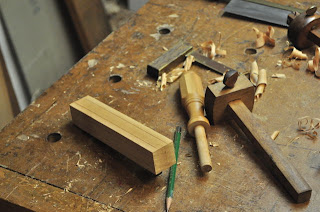I have made bowsaws in the past with metal pins inserted into the handle and a slot to hold the blade. This was unsatisfactory because the pin was epoxied into the handle and eventually worked loose. I've seen examples of older saws that have wooden pins, but that too seems a weak link for a joint in tension. A joint that I've seen on European saws is a metal pin with a flat end that keeps the blade with a bolt and wingnut. I used a hybrid approach, turning the handle and pin as one piece and attaching a flat metal keeper to the wooden pin with brass rivets. The saw blade is attached with a small stainless steel bolt and a wingnut.
The frame is made from cherry, and the cross member tenon has curved shoulders that correspond to the mortise in the sides. This allows these members to rotate slightly in response to tension or wear. Chop the mortises and cut the tenons while the members are still squared up.

Shape the frame elements with a spokeshave, rasp and finish up with sandpaper. Leave the frame full at the handles and joints, but the rest of the frame can be sculpted into graceful slender elements. The Spanish windlass toggle is also a turned element. A deep cove accepts the string and once tightened by rotation, the end is inserted into a small round mortise on the top of the cross member to keep it in place.
The blade is cut to length from a band saw blade. Several different blades can be made up for this saw depending on the intended operation. Band saw blades are easily cut with a cold chisel, just remember to use eye protection and leather gloves. I intend to use this one for dovetails and occasional curve cutting which are mostly rip cuts, so I used a general purpose, 15 tpi bandsaw blade and reduced the set of the teeth by running a sharpening stone down both sides. If desired, the teeth can be reshaped with saw files and a vise; more on that later. I use hemp twine for the windlass. This can usually be found in upholstery supply shops, used to tie springs in furniture. This is a great weekend project with a result you can use for a lifetime.








